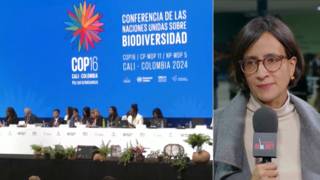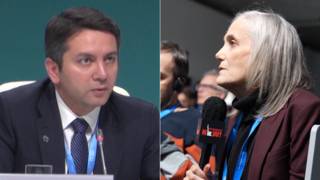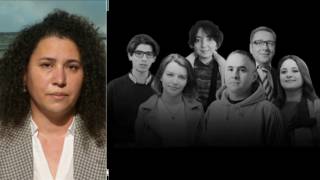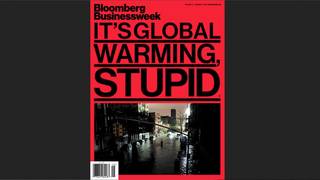
Related
Guests
- Mike BurkeDemocracy Now! senior producer.
- Steve MartinezDemocracy Now! video producer.
- Jessica LeeDemocracy Now! social media coordinator.
In our first broadcast since the Democracy Now! studio regained power, we’re joined by three staffers who have been on the ground taking part in and reporting on the tri-state’s response to Superstorm Sandy: Democracy Now! senior producer Mike Burke, who visited the devastated peninsula of Far Rockaway; Democracy Now! producer Steve Martinez, who lives in northwestern New Jersey and has a family home on the Jersey Shore; and Democracy Now! social media coordinator Jessica Lee, who lives in Red Hook, one of the hardest-hit areas of Brooklyn. [includes rush transcript]
Transcript
AMY GOODMAN: In a moment, we’re going to go to the elections. We’ll be going to Ohio to talk about voter suppression with The Nation magazine’s Ari Berman. But before we do that, a moment ago we played a clip of the Staten Island borough president, James Molinaro, talking about the lack of American Red Cross response, and the Red Cross apologizing, saying, you know, this was such a massive storm. They said afterwards, this is such a massive storm, that it was difficult to actually get there.
Well, Democracy Now! has been on the ground from the beginning. And we’re going to talk about who was there. We’re joined by Democracy Now! senior producer Mike Burke; Jessica Lee, our social media director, who lives in Red Hook; and Steve Martinez, our video producer who lives in New Jersey, the hardest-hit areas of the storm.
Jessica, let’s start with you, because what happened in Red Hook—and, Mike, what you’re talking about, in speaking with the organizer for Occupy Wall Street in Rockaways, was quite stunning, the difference in the response. Jessica?
JESSICA LEE: Right. So, I’ve had sort of this triple hat the last week. I’ve been a resident in Red Hook, also stepping in as an organizer, and also a journalist. So it’s been an interesting experience.
But what happened was, I think this flood in Red Hook has been a mirror for our community to see ourselves. And the organizations that were already in place, the networks, the friendships that were already there, just sprung into action, right the morning after the flood. I think about two-thirds or three-quarters of our neighborhood was flooded by about three or four feet of water, so we’re talking every building, basement and first floor, is wet and needs to be cleaned. Almost all the businesses in Red Hook have been affected by this. And people knew that the morning after, and nobody waited for the city. No one waited to hear anything. They started organizing.
The story of the Red Hook Initiative, which I think has made the news, is really beautiful, because they had no plan. What I heard was that they woke up, they found that the water had come within inches of their building, and they had—still had power. And people started calling them, and they just took action.
So, that started Occupy Red Hook, connected to Occupy Sandy. We got volunteers the next day. Down in the commercial district where I live, on Van Brunt Street, every single business needed help, and neighbors just started helping neighbors. There was no question of we’re waiting for anything. I’ve still not seen the Red Cross. I’ve not seen the city. There’s been some assistance with FEMA paperwork, but really, neighbors all weekend working together with hundreds of people who bicycled to Red Hook.
AMY GOODMAN: I mean, and the extent of the damage in Red Hook—it’s underwater.
JESSICA LEE: It was underwater for only a few hours. It drained away. So, what’s left is very wet furniture, flooring, everything. The walls have to come down. The floors have to come down. And right across the street from my house, actually, this volunteer center sprung out. And I still am not quite sure who’s organizing it, but hundreds of people were down all weekend. And I—they didn’t have a printer, and so I was printing fliers for people to canvas the neighborhood and talk to residents about their needs, whether it was food, medical, whether they needed certain tools. And they would bring that information back. They would reorganize, send volunteers back out. And this is all happening without really anybody knowing who’s in charge.
AMY GOODMAN: So you have this quote of Roger Lowe, Mike, the American Red Cross spokesperson saying, should we have “been there sooner? You bet. When you have eight million people in need, with roads that are damaged, infrastructure broken down, flooding everywhere, we can’t be there that fast. And we [just] feel bad about that.”
MIKE BURKE: What’s remarkable, when we were in the Rockaways, we did see the National Guard, and they were giving away food and some water. FEMA was there, but no one could really quite figure out exactly what they were doing. It almost seemed like they were signing people up for future—for future aid. We did not see the Red Cross anywhere in the Rockaways. We were there for several hours on Friday.
And as I mentioned before, one of the most active relief operations was by Occupy Sandy. And I happen to live in the Brooklyn neighborhood of Sunset Park, which fortunately was not damaged very much at all during the storm. But a local church in Sunset Park, St. Jacobi, opened its doors to Occupy Wall Street organizers to transform the church into this relief center.
And I stopped by there on Saturday and Sunday, and it was a remarkable sight. On Saturday, there were so many people coming to volunteer that there was actually a line snaked around the block of people waiting to go to an orientation to learn how they could help. In the church, there was—they were taking in donations of food. They were preparing literally thousands of hot meals for people in Red Hook, people in the Rockaways, people in Staten Island. They were also collecting clothes. They were collecting blankets. They were collecting cleaning supplies. And they were organizing caravans to go out to these neighborhoods that have been forgotten.
AMY GOODMAN: Who did you speak to there?
MIKE BURKE: Well, one organizer I spoke to, Michael Premo, who was—he was very involved with Occupy Wall Street back when it was in Zuccotti Park, and he started—he was one of the key people that helped get the ball rolling on Tuesday, along with, I should mention, 350.org, the organization founded by Bill McKibben, as well as Recovers.org. But we have a brief interview that I did with Michael Premo, and maybe we could play that now.
AMY GOODMAN: We’re going to go to that clip of the interview with Michael Premo.
MICHAEL PREMO: My name is Michael Primo. I’m from Brooklyn. Right now, we are standing in the church basement space of St. Jacobi Church in Sunset Park, Brooklyn. This is one of two distribution hubs that we have for accepting donations and delivering donations, as well as volunteers, to sites that are set up around the city. Basically, volunteers can come here, as well as donations can come here into this spot. And from here, we load up cars that people line up on the street. Those cars go out full of people and goods to upwards of about 20 recovery sites that are scattered throughout Zone A flood zones throughout South Brooklyn and Staten Island, Red Hook and Queens.
MIKE BURKE: And can you give a sense of how many people have been involved in the Occupy relief effort?
MICHAEL PREMO: Yeah, it’s kind of hard to tell. We’re still getting a sense of all the people that are involved in this effort so far. Yesterday we got about 38,000 unique hits on our website, OccupySandy.org in the morning. And we have a rough estimate that we sent out at least 2,500 volunteers carrying about 15,000 hot meals that were delivered in roughly 120 carloads that were—went out to all of these recovery sites. And those are just kind of like the lowball estimates based on like, kind of like the pounds of food that have been coming through that we’ve been able to like keep a track of.
MIKE BURKE: And how were—how was Occupy able to organize this so quickly?
MICHAEL PREMO: Over the last year, there has been a lot of deep bonds that have been built around these shared values of mutual aid and lateral or horizontal organizing structures, where it’s all about communities building communities. It’s all about individuals building individuals, and supporting up just a rising number of leaders standing side by side. And so, because of that, there’s a huge number of people that have worked together over the last year, that when this tragedy hit, we were able to like just move in to address what needed to be addressed.
AMY GOODMAN: That’s Michael Premo, organizer with Occupy Sandy Relief, was one of the original organizers with Occupy Wall Street.
And New Jersey was very hard hit. Steve Martinez, Democracy Now! producer, you live in New Jersey. A lot of attention paid to how Governor Christie dealt with this, walking side by side with President Obama, basically almost an endorsement of him, not having Mitt Romney come to the state, saying, “I don’t care about presidential politics; I care about the state.” Talk about what happened in New Jersey.
STEVE MARTINEZ: Sure. There’s been—in the sense that it was ground zero for Sandy, the entire state has been impacted by the—by the storm. The northwest area, a lot of trees down. Everyone lost power around us. We didn’t get our power back 'til Friday. My sister is still without power. A lot of businesses have yet to open. The shore has been, well, basically destroyed. We've—we’ve grown up there, my family and I. My children have spent every summer there. And the houses scattered like little match boxes across the shore. We were fortunate to note, from an aerial—an aerial photograph from the National Guard, that our house was actually still sitting on its foundation, but we’re not allowed onto the barrier islands, so we don’t know what kind of damage it sustained at this point.
AMY GOODMAN: The extent of the damage overall in New Jersey, still so many people without power.
STEVE MARTINEZ: I think it’s going to be a very long time before we can really calculate the damage and the long-term ramifications for the state, and perhaps for the national economy. A lot of these houses along the shore, while there were many summer bungalows, a good number of houses that were destroyed were multimillion-dollar mansions that had been built back in the turn of the 20th century that were lost to this storm. A lot of infrastructure destroyed. And a lot of people were financing and refinancing these homes as the value of oceanfront property increased, and now have ended up owing a lot more money than they’re ever going to be able to recover, especially now that the insurance companies are probably going to say that this is a high-risk area to be building in.
AMY GOODMAN: And as we wrap up, Jessica, what do you never leave home without?
JESSICA LEE: Well, we have some rubber gloves. You have your mask, because the mold is becoming really bad in Red Hook. We have a flashlight, because when you go into homes during the day, there’s no power. And you have your—for me, my iPhone charger, because you don’t want to be disconnected, and that’s the way we’re staying connected.
And really, looking forward, I interviewed some organizers yesterday about, well, what’s the next two weeks to look like? You know, what are you planning for the next few weeks? And they had no answer. They said, “We’re just planning for tomorrow,” because these are just normal people planning—they’re really carrying the burden of recovery in the local level, and really systems need to come into place with more resources now.
AMY GOODMAN: And tomorrow is what we’re going to talk about now, because tomorrow is Election Day. New Jersey, they’re talking about emailing voting, because so many voting places—in New York, there are 60 voting places that will not be there anymore.
STEVE MARTINEZ: We received a robocall yesterday that said our polling place has been changed, and it listed a number of counties, and we got no information. What we’re supposed to do now is contact county elections to find out where we’re supposed to go.












Media Options